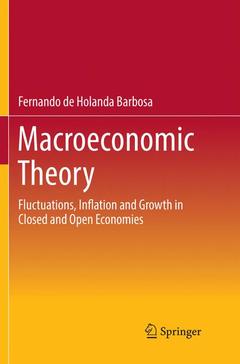Macroeconomic Theory, Softcover reprint of the original 1st ed. 2018 Fluctuations, Inflation and Growth in Closed and Open Economies

Macroeconomics is the application of economic theory to the study of the economy?s growth, cycle and price-level determination. Macroeconomics takes account of stylized facts observed in the real world and builds theoretical frameworks to explain such facts. Economic growth is a stylized fact of market economies, since England?s nineteenth-century industrial revolution. Until then, poverty was a common good for humanity. Economic growth consists in the persistent, smooth and sustained increase of per-capita income. A market economy shows periods of expanding and contracting economic activity. This phenomenon is the economic cycle. The price of money is the amount of goods bought with one unit of money, in other words, the inverse of the price level. Determination of the price level, or the value of money, is a fascinating subject in a fiat money economy.
Date de parution : 01-2019
Ouvrage de 456 p.
15.5x23.5 cm
Date de parution : 10-2018
Ouvrage de 456 p.
15.5x23.5 cm



